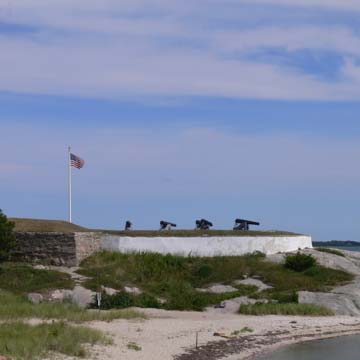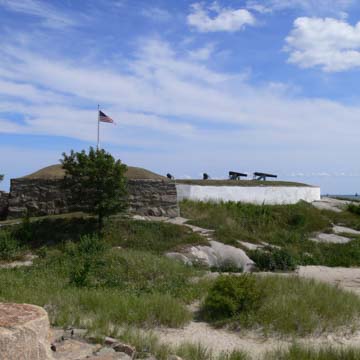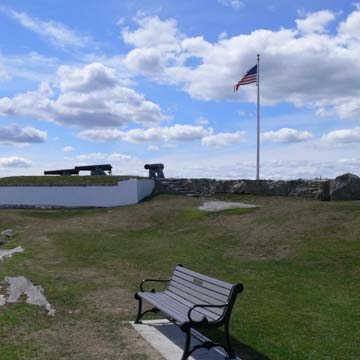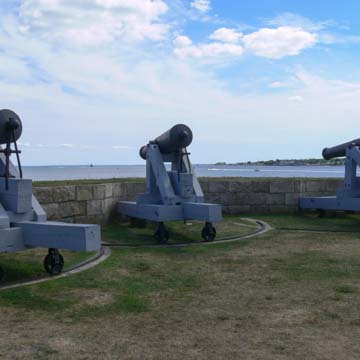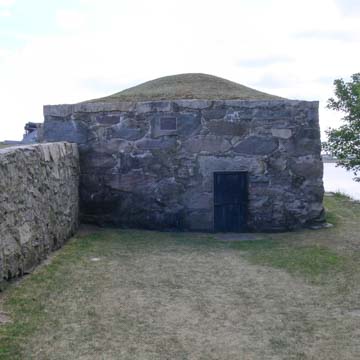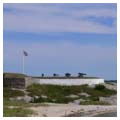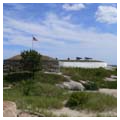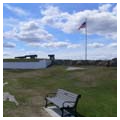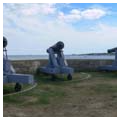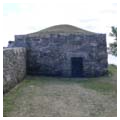The substantial remains of Fort Phoenix in Fairhaven still appear to guard the mouth of the Achushnet River where it flows into Buzzards Bay. The Revolutionary Era fort’s solid earthen walls now stand as a reminder of the local residents’ tenacious resistance to a distant monarchical power and reflects the development of Fairhaven and the region. Buzzard’s Bay and the Achushnet River area have a long history of Native American settlement and later became a center of maritime commerce—particularly whaling—in the late seventeenth and eighteenth centuries.
As early as 1602, explorer Bartholomew Gosnold reported encountering large settlements of Wampanoag tribes living around the mouth of the Achushnet River. In the ensuing decades, European colonists formed an early population center in Dartmouth. In 1659, the first European settlers made their way to what would eventually become Fairhaven, which sits of the east side of the Achushnet River. Agriculture and maritime trade formed the economic foundation for the towns of Fairhaven, Achushnet and New Bedford. Fairhaven officially incorporated in 1812, by which time the whaling industry had begun to thrive in the town.
The need for a fort at the mouth of the Achushnet River became apparent in May of 1775. After the confrontations in Lexington and Concord, General Gage and his British warships found themselves sequestered in Boston Harbor and unable to procure supplies from the mainland. General Gage sent the HMS Falcon south to Martha’s Vineyard and Buzzards Bay to search for and obtain food for British troops. As the Falcon entered Buzzards Bay, 25 militiamen sailed into the bay on a sloop named Success. The crew recaptured two colonial sloops that the Falcon had previously taken; in the process the colonial militia killed one Redcoat and took several others prisoner. This skirmish was one of the first naval engagements in the Revolutionary War.
After this encounter and as Revolutionary fervor spread, residents in Fairhaven took steps protect their harbor from future attacks. In 1777, colonists completed construction of a fort on the northwestern end of Sconticut Neck, the southernmost portion of Fairhaven. Yet the area had not seen the last of violence. The New Bedford and Fairhaven areas were a hotbed of privateering. Ships from the area constantly accosted the British fleet. On September 5, 1778, the British General Grey retaliated against the colonists and landed over 4,000 troops in New Bedford. After setting fire to warehouses, stores, and over seventy ships, the army crossed the Achushnet River into Fairhaven. Knowing the large British force was advancing, the militia retreated from the fort. The British destroyed the fort by disabling the cannons, setting fire to the barracks, and blowing up the magazine. Though a nearby militia put up some resistance afterwards, they were far outnumbered. The successful British troops left the next day. After the attack, the local militia immediately began erecting a new fort on the same site. The militia’s swift work raising a new fort from the ashes of the old led to its new name: Fort Phoenix.
The rebuilt fort, which likely resembled the original, has a horseshoe-shaped outer wall composed of fieldstones and brick, with a smooth natural cement coating, and is topped with tapered granite blocks. Fort Phoenix’s irregularly shaped revetment follows the contours of the promontory on which it was built. Builders filled the space between the outer and an inner walls with earth, forming a solid parapet. The fort’s inner wall, made from cut granite, forms a rough square with the west wall at an oblique angle. Guns were mounted on larges slabs of granite cut to fit into semicircular recesses in the inner wall. The militia could rotate cannons 180 degrees on these granite “truck runs” using handspikes. The northwest revetment wall ends in a large, rectangular, underground powder magazine. Exterior stone walls sheath the magazine’s interior brick vault. Turf covers the roof of the magazine, and militia accessed it through a ramped stone tunnel. The fort’s solid stone construction better protected the fort from naval artillery than wooden construction, which was typical of concurrent inland forts.
Fort Phoenix was expanded before the onset of the War of 1812 and helped to repel an attack on the area by the British warship HMS Nimrod. Soldiers manned the fort throughout the Civil War and cannons from this era remain at the site. The army decommissioned the fort in 1876. In 1926, a wealthy supporter of the town purchased the fort and gifted it to Fairhaven. The town-owned property, adjacent to a state-owned recreational area and beach, is now open to the public. Interpretive panels recount Fort Phoenix’s story, and historical encampments take place there twice annually. The solid walls and silent cannons connect contemporary visitors to the sacrifices of those who fought for independence.
References
Bernard, Donald. Tower of Strength: A History of Fort Phoenix, Fairhaven, MA. New Bedford, MA: Reynolds-Dewalt, 1975.
Bernert, Julia. “Form F – Structure: Fort Phoenix, Fairhaven, MA (FAI.900).” Boston: Massachusetts Historical Commission, December 2007.














